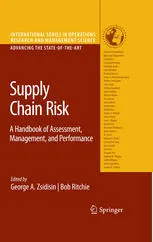Supply Chain Risk: A Handbook of Assessment, Management, and Performance
4.9
Reviews from our users

You Can Ask your questions from this book's AI after Login
Each download or ask from book AI costs 2 points. To earn more free points, please visit the Points Guide Page and complete some valuable actions.Introduction
In today’s interconnected and volatile global landscape, the concept of supply chain risk has evolved from being a peripheral concern to a central focus for businesses striving to maintain competitive advantage and operational resilience. “Supply Chain Risk: A Handbook of Assessment, Management, and Performance”, edited by George A. Zsidisin and Bob Ritchie, provides an authoritative and comprehensive exploration of this critical discipline. This book caters to both practitioners and scholars seeking a deep understanding of the challenges, frameworks, and strategies associated with supply chain risk management (SCRM).
By bringing together leading academics, researchers, and industry experts, the handbook offers a balanced blend of theory and practical insights. Through real-world examples, rigorous methodologies, and actionable tools, it equips readers with the knowledge they need to navigate complex supply chain environments effectively. Whether you are facing the challenges of natural disasters, cyber threats, geopolitical tensions, or supplier disruptions, this book offers solutions that are both customizable and scalable.
Detailed Summary of the Book
The book is divided into multiple sections, each addressing a core aspect of supply chain risk management. It begins by framing the concept of supply chain risk, offering definitions, terminology, and key frameworks to highlight its significance in modern business environments. The authors delve into the triggers and causes of disruptions, breaking down macroeconomic, geographic, and organizational-level factors that can threaten supply chain stability.
A significant portion of the book focuses on risk assessment techniques. This section introduces robust tools such as risk mapping, probability impact grids, and scenario planning. Readers are guided through the steps to identify vulnerabilities in their supply chain, calculate risk exposure, and use data-driven methodologies to evaluate the probability and impact of disruptive events.
Another pivotal theme is risk mitigation. The handbook emphasizes proactive strategies such as supplier diversification, collaborative relationships, and digital transformation to enhance forecasting and visibility. The authors also explore traditional and emerging risk transfer mechanisms, including insurance, smart contracts, and blockchain-based technologies.
What sets this book apart is its coverage of organizational performance and value creation in the context of SCRM. By aligning risk management objectives with corporate goals, the authors demonstrate how organizations can turn risk management into a value-adding function. This part of the book includes metrics and performance indicators to track the effectiveness of SCRM initiatives and align them with broader business outcomes.
Key Takeaways
- A deep understanding of the multi-faceted nature of supply chain risks and their triggers.
- Practical methodologies and tools for comprehensive risk assessment and analysis.
- Actionable strategies for mitigating and managing supply chain risks proactively.
- Insights into using digital technologies for supply chain visibility and resilience.
- Approaches to integrate risk management into overall business performance optimization.
Famous Quotes from the Book
“Supply chain risk management is not about eliminating risk, but about anticipating potential disruptions and preparing to respond in ways that minimize impact and maximize opportunity.”
“The world of supply chains is governed by uncertainty. Success is not achieved by avoiding disruptions, but by mastering the art of resilience in the face of uncertainty.”
Why This Book Matters
The importance of this book lies in its ability to address one of the most pressing challenges faced by organizations in the 21st century. In an era of globalization and digital transformation, supply chain risks have become more pronounced and their management more complex. This handbook bridges the gap between academic rigor and practical application, offering readers evidence-based solutions and best practices.
For businesses, the ability to foresee, quantify, and respond to risks is a cornerstone of long-term competitiveness. This book provides tools to transform risks into opportunities, helping organizations foster resilience and reliability. For scholars and students, it opens up new avenues for research and provides a solid foundation in this rapidly evolving field.
Ultimately, “Supply Chain Risk: A Handbook of Assessment, Management, and Performance” is not just a handbook—it’s a vital resource for anyone committed to strengthening supply chain networks and ensuring sustainable business success.
Free Direct Download
You Can Download this book after Login
Accessing books through legal platforms and public libraries not only supports the rights of authors and publishers but also contributes to the sustainability of reading culture. Before downloading, please take a moment to consider these options.
Find this book on other platforms:
WorldCat helps you find books in libraries worldwide.
See ratings, reviews, and discussions on Goodreads.
Find and buy rare or used books on AbeBooks.


